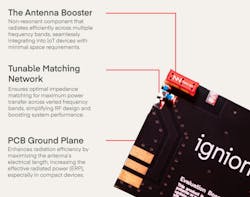Ignion's Virtual Antenna design is an alternative to the more common flexible printed circuit (FPC), also known as a “sticker antenna.” The FPC, with its adhesive backing strip and cable, is used in compact IoT wireless applications. FPCs require precise cable routing and assembly to deliver optimum performance. Improper design or assembly can result in suboptimal performance in the field.
The Virtual Antenna technology is designed to support multi-band, multi-protocol antenna solutions (see figure).
The Virtual Antenna consists of a matching network circuit and a Virtual Antena component that's essentially the antenna aspect of the system. These are mounted above a printed-circuit-board (PCB) ground plane. The matching system and antenna selection is accomplished with Ignion's online design tool called Oxion.
The designs target a surface-mount-device (SMD) component from Ignion that remains the same regardless of the protocols being employed. The matching system manages this so that the problem becomes an RF circuit design challenge, which is handled by the Oxion design tool. The system basically uses the PCB as the antenna. The overall design is smaller than the usual FPC solution but provides the same or better performance and efficiency.
This approach can simplify initial design. It also makes subsequent designs or improvements easier as additional wireless support can be accommodated with the same hardware plus an adjustment in the electrical matching support. The designs can handle harsh environments of up to 125ºC.
The biggest challenge for designers is that the Virtual Antenna is a PCB-based solution rather than an external antenna. It means the decision must be made before the PCB design process gets underway. This is due to the dependency on the PCB ground-plane dimensions.




